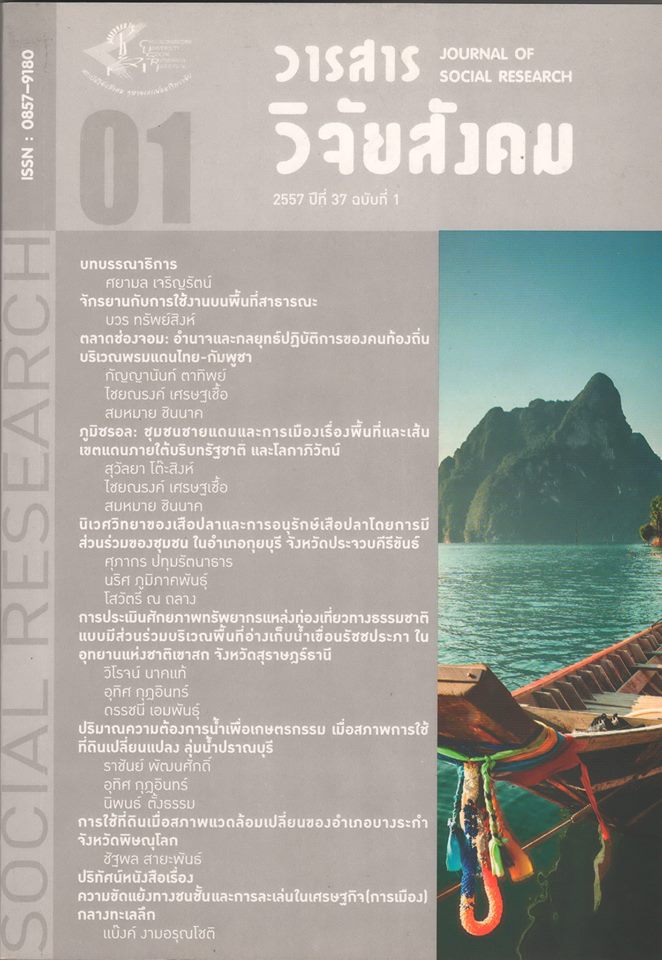ภูมิซรอล: การเมืองเรื่องพื้นที่ความเป็นเส้นเขตแดนของผู้คนบริเวณพรมแดนภายใต้บริบทรัฐชาติและโลกาภิวัตน์
Main Article Content
บทคัดย่อ
ารขึ้นทะเบียนปราสาทพระวิหารเป็นมรดกโลกขององค์การศึกษาประวัติศาสตร์และวัฒนธรรมแห่งสหประชาชาติ (UNESCO) ได้นำมาสู่ความขัดแย้งอย่างรุนแรงระหว่างไทยและกัมพูชาที่เกี่ยวโยงกับความเป็นเส้นเขตแดนและการให้ความหมายพื้นที่ชายแดน บทความนี้จะอธิบายถึงการให้ความหมายของพื้นที่ชายแดนไทย-กัมพูชาโดยใช้แนวคิดพื้นที่ (Space) และแนวคิดกลยุทธ์ปฏิบัติการในชีวิตประจำวัน (Tactics of every life practice) โดยมีประเด็นสำคัญ คือ การอธิบายบริบททางประวัติศาสตร์ของเส้นเขตแดนไทย-กัมพูชาบริเวณปราสาทพระวิหาร การให้ความหมายพื้นที่ชายแดนของฝ่ายต่างๆ และผลกระทบต่อผู้คนบริเวณพรมแดน ผู้เขียนเก็บข้อมูลในพื้นที่บ้านภูมิซรอล ตำบลเสาธงชัย อำเภอกันทรลักษ์ จังหวัดศรีสะเกษ ในช่วงระหว่างปี พ.ศ. 2554 – 2556 โดยการวิจัยเอกสาร การสังเกตการณ์แบบมีส่วนร่วม และการสัมภาษณ์ผู้ให้ข้อมูลสำคัญ พบว่าแต่เดิมในยุครัฐแสงเทียนยังไม่มีการขีดเส้นเขตแดน ปราสาทพระวิหารเป็นเพียงปราสาทร้าง แต่ปัจจุบันได้มีการให้ความหมายที่ซ้อนทับกันระหว่างฝ่ายต่างๆ จนกลายเป็นความขัดแย้ง และกระทบต่อวิถีชีวิตของคนภูมิซรอลที่ให้ความหมายพื้นที่ชายแดนและเส้นเขตแดนแตกต่างไปจากคนนอก
บทความนี้เสนอว่า ในยุคโลกาภิวัตน์ความคิดเกี่ยวกับเส้นเขตแดนได้เปลี่ยนไป ดังกรณีนี้ที่ปราสาทพระวิหารได้ขึ้นทะเบียนเป็นมรดกโลกแต่ขณะเดียวกันกลับมีการต่อสู้ช่วงชิงเพื่อครอบครองอาณาบริเวณ และความขัดแย้งนี้ได้รับผลกระทบต่อกัน โดยวงวิชาการเชื่อว่าเส้นเขตแดนมีความหมายน้อยลงหรือเป็นการสลายการครอบครองอาณาบริเวณ (Deterritorialization) แต่กรณีความขัดแย้งในการขึ้นทะเบียนปราสาทพระวิหารเป็นมรดกโลก เส้นเขตแดนกลับมีความหมายต่อทั้งสองรัฐชาติ แต่เสียงของชาวบ้านกลับไม่ถูกให้ความสำคัญชาวบ้านเองได้มีการคิดค้นกลยุทธ์ต่างๆ เพื่อต่อรองซึ่งเป็นกลยุทธ์ที่ทำให้เสียงของตนเองมีความหมายมากยิ่งขึ้น
PhumSarol: The Politics of Spaceand Borderline and Livelihood of Local people at The Borderland in the Context of Nationalism and Globalization.
Stemming from the endorsement of PreahVihear Temple as the world cultural heritage site under the United Nations Educational, Scientific and Cultural Organization (UNESCO), an intense conflict has been raising between Thailand and Cambodia relevant to the boundary and the definition of borderline of the two countries. This article aims to give a descriptive definition of the borderline of Thai-Cambodian through the concepts of space as well as arts of the weak. The main point of the study is to explain a historical context of the borderline of Thai-Cambodian at PreahVihear Temple, the definitions of boundary from different parties, and influences on people along the border. The data collection was conducted through documentary research, participant observations, and key informant interview in Baan PhumSarol, Souw-thong-chai Sub-district, Kantaraluk District, Srisaket Province from 2011 to 2013. The findings revealed that there was no boundary line setting in the Mandala period. Preah Vihear Temple was only a desolate stronghold at that moment. However, the overlapping definition, at present, among different parties becomes the conflict and influences on livelihoods of people in PhumSarol who define the meaning of this borderline and boundary different from the outsiders.
This article, subsequently, would like to propose a changeable concept of borderland in the context of globalization. Regarding the PreahVihear Temple, not only does a matter of endorsement as the world cultural heritage, it also reveals a struggle of political power on the annexation as the influent conflicts. In line with academic field, it is believed that the definition of borderland becomes weak. In other words, it is a form of deterritorialization. In the case of conflict in endorsement the PreahVihear Temple as the world cultural heritage, notwithstanding, the borderland was given as a significant definition between the two nation-states without concerning people’s views in those areas. The people themselves must find their tactics to negotiate as the weaklings to raise their voices for highly meaningful consideration.
Article Details
1) บทความนี้เป็นลิขสิทธิ์ของสถาบันวิจัยสังคม จุฬาลงกรณ์มหาวิทยาลัย แต่ความคิดเห็นและเนื้อหาเป็นของผู้แต่ง
2) ทัศนะและความคิดเห็นที่ปรากฏในบทความในวารสารวิจัยสังคมและปริทัศน์ สถาบันวิจัยสังคม จุฬาลงกรณ์มหาวิทยาลัย ถือเป็นความรับผิดชอบของผู้แต่งบทความนั้น และไม่ถือเป็นทัศนะและความรับผิดชอบของกองบรรณาธิการวารสารวิจัยสังคมและปริทัศน์ สถาบันวิจัยสังคม จุฬาลงกรณ์มหาวิทยาลัย กองบรรณาธิการไม่สงวนสิทธิ์ในการคัดลอก แต่ให้ระบุถึงการอ้างอิง


